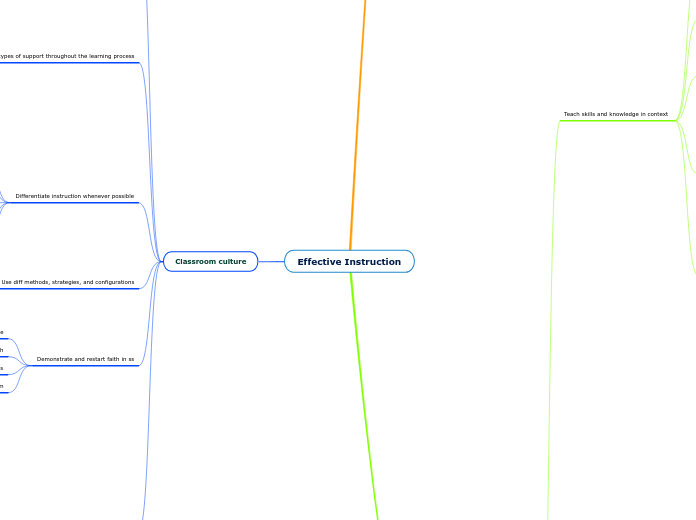par Sierra Ali Il y a 4 années
146
Effective Instruction
Teaching should emphasize the integration of skills and knowledge within meaningful contexts, encouraging students to identify and solve problems through authentic learning experiences.

par Sierra Ali Il y a 4 années
146

Plus de détails
evaluate your own materials
speak with ss privately
create the conditions for taking risks
establish your policies and values immediately
model respectful language
validate ss struggles
use a grading system that allows ss to take risks
spend more time on assignments ‘
provide examples of what successful performance looks like
connect all instruction to the world at large
analyze the “performance of understanding” for key skills
return to these big ideas, understandings, and essential questions
ask ss to demonstrate their degree of understanding
make available a range of possible means
decide what you want ss to understand
realize that as ss do more complex work they will need further support
allow ss to apply what they have learned
offer feedback verbal, written, or visual
give ss tools and strategies to use
provide appropriate and repeated demonstrations of the expected academic behavior
think about when are you teaching
remember who you are teaching
examine how you are trying to teach
consider what you are trying to teach
evaluate why you are teaching something
reinforce for ss what you expect them to learn
ask yourself how
provide a clear rationale
invite dramatic representations
their ?s that will intrigue
bring in film, music, art
pose hypothetical questions
assign certain ss the role
bring in outside material
monitor class discussions or interactions
evaluate the content for possible controversies
consult the state standards for key instructional content
create a three column chart (past present future)
teach ss to teach themselves
draw a continuum on board
use web sites that foster the making of connections
make connections to tests by asking ss to Create sample test questions
create a three-column poster with sentence starters
ask ss to create different metaphors and similes
model for ss how to make the kid of connections
create a chart of the different types connections
ask ss to note take
prepare study guides
generate questions
use graphic organizers
bring diff perspectives in through alternative versions of a text
ask ss to consider how diff groups
use a graphic organizer with a circle
incorporate into your curriculum a range of voices
require SS to come up with several ways to solve the same problem
connect w/ current conversation
begin w/ end result in mind
keep a running narrative of connections
what subject or question is the focus
choose subjects and texts that have some connection to each other
show that you expect all SS to have good ideas
provide support SS need in order to enter into and contribute into conversations
choose materials from range of perspectives
give ss choice:
social action projects
multi media
writing
organize the class into groups
provide alternative experiences
arrange set texts
post visual of big idea
generate ideas
create an essential question
identify the core subject
move beyond basic knowledge into such advanced critical thinking
post certain declarative and procedural knowledge
monitor skills taught
model and incorporate skills
what skills are necessary
examine the time you spend on each element of the pattern
evaluate the language you use to set up, teach, and explain your curriculum
compare your pattern with those of ts you respect
identify the verbs that characterize the diff stages
analyze your class over several days
support your ss in a variety of ways
vary the duration of the activity or exercise
increase the complexity or difficulty by adding new elements
vary the means and materials ss use
add complexity as ss begin to show initial mastery
design learning experiences using context rich activities
what do we want ss to know?
organize around essential questions
have ss identify and solve problems
embed skills and knowledge instruction
discuss different ways ss use tools
ask ss t reflect
allow ss to invent
use technology to show the same subject from multiple perspectives
what can be added to each assignment
choose the proper tool
avoid distracting features
plan ahead when using technology
give ss clear instructions
provide feedback and follow through
communicate, collaborate, or investigate
generate
analyze
collect, measure, capture, record
organize
present
use evidence
design discussion questions
collect work in the middle of the process
monitor work in class
ss compare work
ss reflect
use rubric
pause and assess
ss set personal goals
give ss scoring rubric
provide examples
demonstrate for ss
post objectives clearly
use an assignment sheet
summative
formative
diagnostic
class discussion
informal writing
graphic organizer
observe
pretest
building personas
organizing personas
learning personas